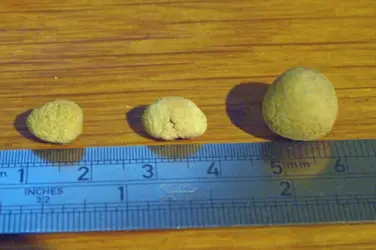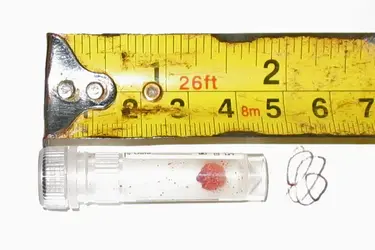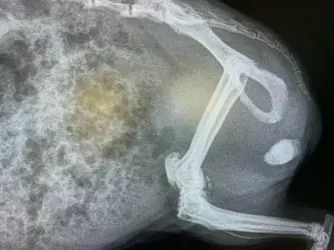1 The Urinary Tract
2 Pees
- Water intake changes
- Pee discoloration
3 Infections
- Bacterial urine infection (UTI)
- Bacterial cystitis
- Sterile cystitis (interstitial cystitis or IC)
4 Stones, Sludge and Crystals
- Crystals, stones and sludge
- Stone and sludge removal
5 Kidneys and Bladder Cancer
- Kidney infections and failure
- Bladder cancer
Wiebke's Guides are a series of articles I have written for Guinea Pig Magazine in 2023 and 2024.
They are there to help you understand how the urinary tract works, learn to spot what is normal and what not and what are the most common health issues connected with it.
1 The Urinary Tract
The urinary tract starts in the two kidneys located higher up in the body towards the spine where any fluid waste is processed and excreted in the form urine.
A tube called a ureter runs from each kidney into the bladder which acts as a holding tank that is emptied when it is full.
This happens via a single larger tube called the urethra which carries the urine to the exit. The urethra is one of the areas where there is a physical gender difference. It is shorter and straighter in sows whereas boars have a longer urethra with an awkward inglenook widening in it where any debris, like stones or crystals can get caught and stuck. In sows the narrowest point is the muscular ring that controls the exit opening where any stones tend to fetch up.
Pee is a very corrosive substance that stings badly when it comes in contact with raw tissue or a small rip. The walls of urinary tract are coated by a layer of natural glucosamine that acts as insulation and enables the normal smooth operation of urinary tract.
Infections can affect this glucosamine layer and stones, sludge and crystals can scratch it as they are banged painfully around the bladder with every pee. The intense pain from the pee hitting raw tissue is what causing the screaming when peeing.
2 Pees
The urine concentration usually depends on how much your piggy is individually drinking. This can vary from a bottle or more per day to not drinking at all and just getting the fluid from the veg. It is worth noting that this is the normal spectrum and that the concentration of urine doesn’t have any impact on the kidney function.
Water intake changes
It is also worth keeping in mind that the need to drink comes before the need to eat. A guinea pig that is fully eating and holding their weight is also drinking, unless water is not available (run out, blocked nozzle, frozen or too hot water bottle or spoiled water dish or bad taste from additives, green algae overgrowth etc.). Make sure that a guinea pig with mobility issues or old age arthritis (lifting the head) can still reach a bottle or offer regular watering support via syringe.
What you need to keep an eye on are noticeable changes to the fluid intake. First always check whether the water source is OK. Then consider whether there are any major changes in the environment in terms of temperatures or humidity like heat or cold spikes, air conditioning or radiator heat coming on etc. which can also decrease or increase the water intake shortly without any major changes to the weight.
Decreased fluid intake
A decrease of fluid intake very often comes hand in hand with a loss of appetite; when support feeding, you should also always offer water; about 1 ml for every 5 ml of solids. Please never just squirt any water or feed into the mouth at full force. It will go mostly up into the nose (causing temporary congestion noises) but it can end up in the bronchia or lungs (aspiration) if it coincides with an intake of breath. Make sure that you only ever give 0.1-0.3 ml in one go to a piggy that is fighting the syringe, depending on age and weakness. An adult piggy can hold about 0.5 ml in their mouth. Make sure that they have swallowed everything before giving more – slowly and gently.
Causes of a decreased water intake can include dental overgrowth or a fungal mouth infection (oral thrush), which are making swallowing difficult.
Runny diarrhoea, painful belly cramps and bloating but also any obstructions in the mouth, throat or digestive tract.
Any serious respiratory illnesses will firstly kill of the appetite and then the thirst since the need to breathe comes before the need to drink and then the need to eat.
Increasing weakness/apathy and heat stroke will also lead to a decrease or stop in drinking.
Total loss of appetite as a side effect to antibiotic treatment or as a reaction to GA drugs in the wake of an operation also means that you need to make sure that your piggy is offered water with every feeding feeding session.
Signs of acute dehydration:
Please see a vet when you notice a sudden or quick persistent increased drinking especially in combination with weight loss.
In the majority of cases this caused by kidney issues or an infection especially in the urinary tract but other infections in the body can also lead to a higher water intake if the appetite is not killed off. Diabetes is after an initial fad of over-diagnosing actually not all that common but needs to be taken into account once the kidneys and any infections have not checked out.
Pee Discoloration
Urine concentration, the natural oxidising process when in contact with air, blood, natural dyes and bacterial overgrowth can all contribute to the coloured patches of pee you find when cage cleaning.
Here is a quick guide to urine and urine puddles:
2 Pees
- Water intake changes
- Pee discoloration
3 Infections
- Bacterial urine infection (UTI)
- Bacterial cystitis
- Sterile cystitis (interstitial cystitis or IC)
4 Stones, Sludge and Crystals
- Crystals, stones and sludge
- Stone and sludge removal
5 Kidneys and Bladder Cancer
- Kidney infections and failure
- Bladder cancer
Wiebke's Guides are a series of articles I have written for Guinea Pig Magazine in 2023 and 2024.
They are there to help you understand how the urinary tract works, learn to spot what is normal and what not and what are the most common health issues connected with it.
1 The Urinary Tract
The urinary tract starts in the two kidneys located higher up in the body towards the spine where any fluid waste is processed and excreted in the form urine.
A tube called a ureter runs from each kidney into the bladder which acts as a holding tank that is emptied when it is full.
This happens via a single larger tube called the urethra which carries the urine to the exit. The urethra is one of the areas where there is a physical gender difference. It is shorter and straighter in sows whereas boars have a longer urethra with an awkward inglenook widening in it where any debris, like stones or crystals can get caught and stuck. In sows the narrowest point is the muscular ring that controls the exit opening where any stones tend to fetch up.
Pee is a very corrosive substance that stings badly when it comes in contact with raw tissue or a small rip. The walls of urinary tract are coated by a layer of natural glucosamine that acts as insulation and enables the normal smooth operation of urinary tract.
Infections can affect this glucosamine layer and stones, sludge and crystals can scratch it as they are banged painfully around the bladder with every pee. The intense pain from the pee hitting raw tissue is what causing the screaming when peeing.
2 Pees
The urine concentration usually depends on how much your piggy is individually drinking. This can vary from a bottle or more per day to not drinking at all and just getting the fluid from the veg. It is worth noting that this is the normal spectrum and that the concentration of urine doesn’t have any impact on the kidney function.
Water intake changes
It is also worth keeping in mind that the need to drink comes before the need to eat. A guinea pig that is fully eating and holding their weight is also drinking, unless water is not available (run out, blocked nozzle, frozen or too hot water bottle or spoiled water dish or bad taste from additives, green algae overgrowth etc.). Make sure that a guinea pig with mobility issues or old age arthritis (lifting the head) can still reach a bottle or offer regular watering support via syringe.
What you need to keep an eye on are noticeable changes to the fluid intake. First always check whether the water source is OK. Then consider whether there are any major changes in the environment in terms of temperatures or humidity like heat or cold spikes, air conditioning or radiator heat coming on etc. which can also decrease or increase the water intake shortly without any major changes to the weight.
Decreased fluid intake
A decrease of fluid intake very often comes hand in hand with a loss of appetite; when support feeding, you should also always offer water; about 1 ml for every 5 ml of solids. Please never just squirt any water or feed into the mouth at full force. It will go mostly up into the nose (causing temporary congestion noises) but it can end up in the bronchia or lungs (aspiration) if it coincides with an intake of breath. Make sure that you only ever give 0.1-0.3 ml in one go to a piggy that is fighting the syringe, depending on age and weakness. An adult piggy can hold about 0.5 ml in their mouth. Make sure that they have swallowed everything before giving more – slowly and gently.
Causes of a decreased water intake can include dental overgrowth or a fungal mouth infection (oral thrush), which are making swallowing difficult.
Runny diarrhoea, painful belly cramps and bloating but also any obstructions in the mouth, throat or digestive tract.
Any serious respiratory illnesses will firstly kill of the appetite and then the thirst since the need to breathe comes before the need to drink and then the need to eat.
Increasing weakness/apathy and heat stroke will also lead to a decrease or stop in drinking.
Total loss of appetite as a side effect to antibiotic treatment or as a reaction to GA drugs in the wake of an operation also means that you need to make sure that your piggy is offered water with every feeding feeding session.
Signs of acute dehydration:
- A waxy, stiff coat
- Very dry and shrivelled fresh poos or tiny poos with a mucus coating – the latter means that a guinea pig has not eaten or drunk in 24 hours and is a life or death emergency
- Sunken eyes (on both sides)
- A single shrivelled eye is severely dehydrated often as a result of an injury. Please see a vet as soon as you can.
The eye – unless it has burst – can be rehydrated with artificial tear fluid (ideally a carbomer based tear gel) but the injury will still have to be properly treated for an infection and further damage if at all possible. If you are lucky, sight may return.
A stroke piggy may no longer be able to clean the eye on the affected side of the body and will require regular rehydration with tear gel.
Please see a vet when you notice a sudden or quick persistent increased drinking especially in combination with weight loss.
In the majority of cases this caused by kidney issues or an infection especially in the urinary tract but other infections in the body can also lead to a higher water intake if the appetite is not killed off. Diabetes is after an initial fad of over-diagnosing actually not all that common but needs to be taken into account once the kidneys and any infections have not checked out.
Pee Discoloration
Urine concentration, the natural oxidising process when in contact with air, blood, natural dyes and bacterial overgrowth can all contribute to the coloured patches of pee you find when cage cleaning.
Here is a quick guide to urine and urine puddles:
- Pee concentration
Pee is the more yellow the more it is concentrated when it leaves the body. This is not something to worry about unless you are dealing with very watery pee and weight loss in a piggy that is not normally drinking a lot.
- Oxidised Urine
Clear pee when leaving the body dries normally in increasingly darker shades of orange to rusty tones with the rim of the puddle always darker but in the same colour range. The intensity of the discoloration depends on the concentration of the urine, the amount of bacteria and the drying time – the longer the darker the shade.
Oxiding fresh pee (was clear when leaving the body)
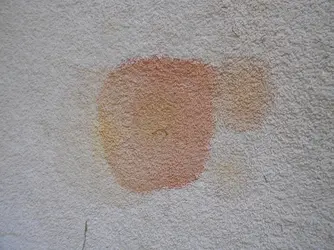
Dried in strongly oxidised pee
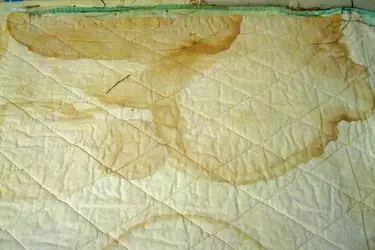
- Blood
Sheer blood appears as a pinkish or sometimes orange shade when fresh but dries off to a small dull brown patch that is quite distinct from the usual rusty colours.
When mixed with urine is more common to find drops of pink/brown in a pee puddle and/or a distinctly brown and not rusty ring around the puddle when there is a lot of it.
However, you want to see some other urinary symptoms before you jump to the conclusion of having a bloody pee puddle if you are inclined to panic.
Porphyrin coloured pee puddle
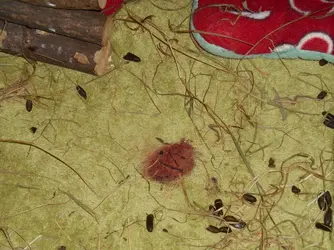
Natural dyes in pee
Porphyrin appears red and also dries to a dull brown.
Tomato juice can cause bright red drops.
Died cherry tomato drops filtered through a fleece

Occasionally veg can cause orange pees; not just carrots, but lettuce, cucumber or grass, too. This is perfectly harmless. Beetroot is a strong natural food dye and will always appear as purplish pink pee and dry in shades purple. Beetroot poos are purple coloured.
Pink beetroot pee in a drip dish
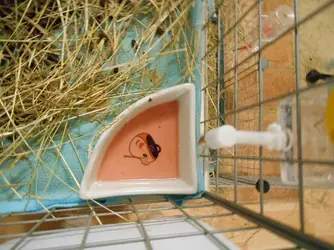
- Bacterial overgrowth
Intense orange pees drying to a deep, rich rusty tone are rare but they can cause a panic because of the richness of colour. They are caused by a usually suppressed form of bacteria in the bladder that can flourish in the course of repeated bladder stone or antibacterial treatment when the immune system is suppressed. It can be easily treated with antibiotics and an immune boosting 2-3 weeks vitamin C course.
In the corner you can see the intensely orangey pee (which happened in the wake of several courses of antibiotics
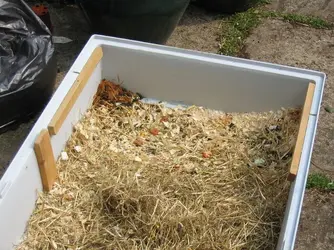
- White calcium pees
The normal way of the body to excrete any excess calcium is via the kidneys. These white pees dry as powdery white patches. The occasional white patch is not a problem at all; it means just that the process is working. A calcium pee hitting a poo can give it a white crust.
A cluster of calcium pees in a day or two can in some cases signal the onset of a sterile cystitis flare but you want to review your diet if you see calcium pees on a regular, daily or near daily basis and you want to see a vet if you feel/find sharp solid bits (crystals) in those patches.
Please also be aware that a diet too low in calcium can also lead to the excretion of calcium and calcium pees. It is unfortunately not quite as straight forward as you may wish.
